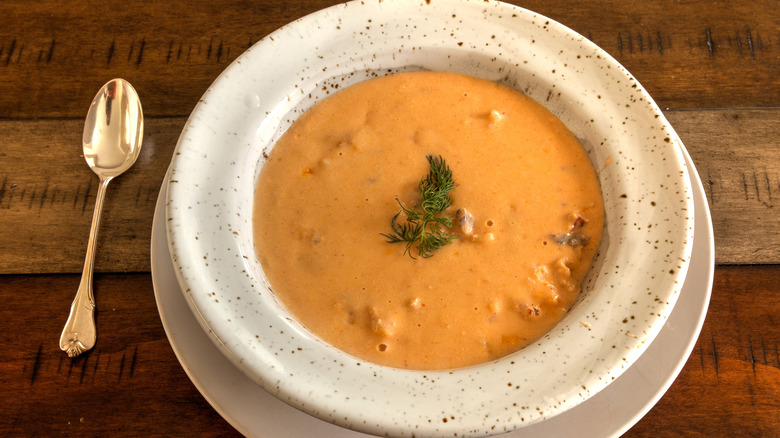Why Salmon Is A Worthy Alternative To Lobster For Your Next Bisque
The velvety, smooth flavor of lobster bisque is almost unparalleled. With a creamy texture and incredible taste of lobster that's bolstered with carrots, celery, and tomato paste, it's one of our favorite comfort dishes. Yet, while lobster is delicious, salmon is a worthy contender for a spot in bisque.
Lobster has a luxurious reputation, and for good reason. It's sweet with a light, clean taste, making it a more sought-after crustacean. At the top of its own seafood category, salmon is a delicious fish that leans rich. Although lobster is lighter, salmon's fattiness means it was made for bisque, a soup known for its thick, creamy texture. Salmon isn't as sweet as lobster, but it makes up for it with a buttery taste. Salmon has already proved itself to be a delectable cornerstone for soup, bringing a boldly flavorful touch to Tom Kha-inspired salmon and corn chowder. So, for a flavorful alternative to a classic seafood bisque, try it there too.
One of the key components of a rich and creamy lobster bisque is a stock that comes from simmering the crustacean's shells. Salmon doesn't come with its own hardened exterior, but you can easily use store-bought stock instead. Seafood stock brings a fresh, sweet flavor, though some recipes opt for chicken stock to make bisque that's more savory. After the stock has simmered with herbs and vegetables for some time, add in the flaked salmon along with heavy cream and tomato paste, and blend with an immersion blender.
What kind of salmon should you use for bisque?
Using canned salmon is probably the quickest way to make a salmon bisque. It comes cooked and flaked, so all you need to do is dump it into the simmering liquid before blending until smooth. Canned salmon typically comes packed in water, so you can stir that into the stock for a fishier taste or drain it first for a thicker consistency.
If you do want bisque that tastes a little more fresh, purchase a salmon filet from the grocery store or fishmonger. Poaching salmon takes about 15 minutes and you can use the poaching liquid to flavor the bisque. Water and stock are easy options, but for a little more complexity, use white wine. Poaching salmon filets in olive oil also brings more flavor while giving the bisque a richer mouthfeel. Once the salmon is cooked, simply flake it apart and add it to the simmering liquid. You can also set some aside to finish off the bisque.
While those cooking methods produce moist fish, which is always a good idea for bisque, some people choose to broil or pan-sear their salmon. With broiling, the salmon remains tender on the inside while taking on a crisp coating that can top off the bisque once it's cooked. Pan-searing also gives the salmon a crunchier exterior, although it provides the fish with a caramelized taste that makes your bisque richer.

